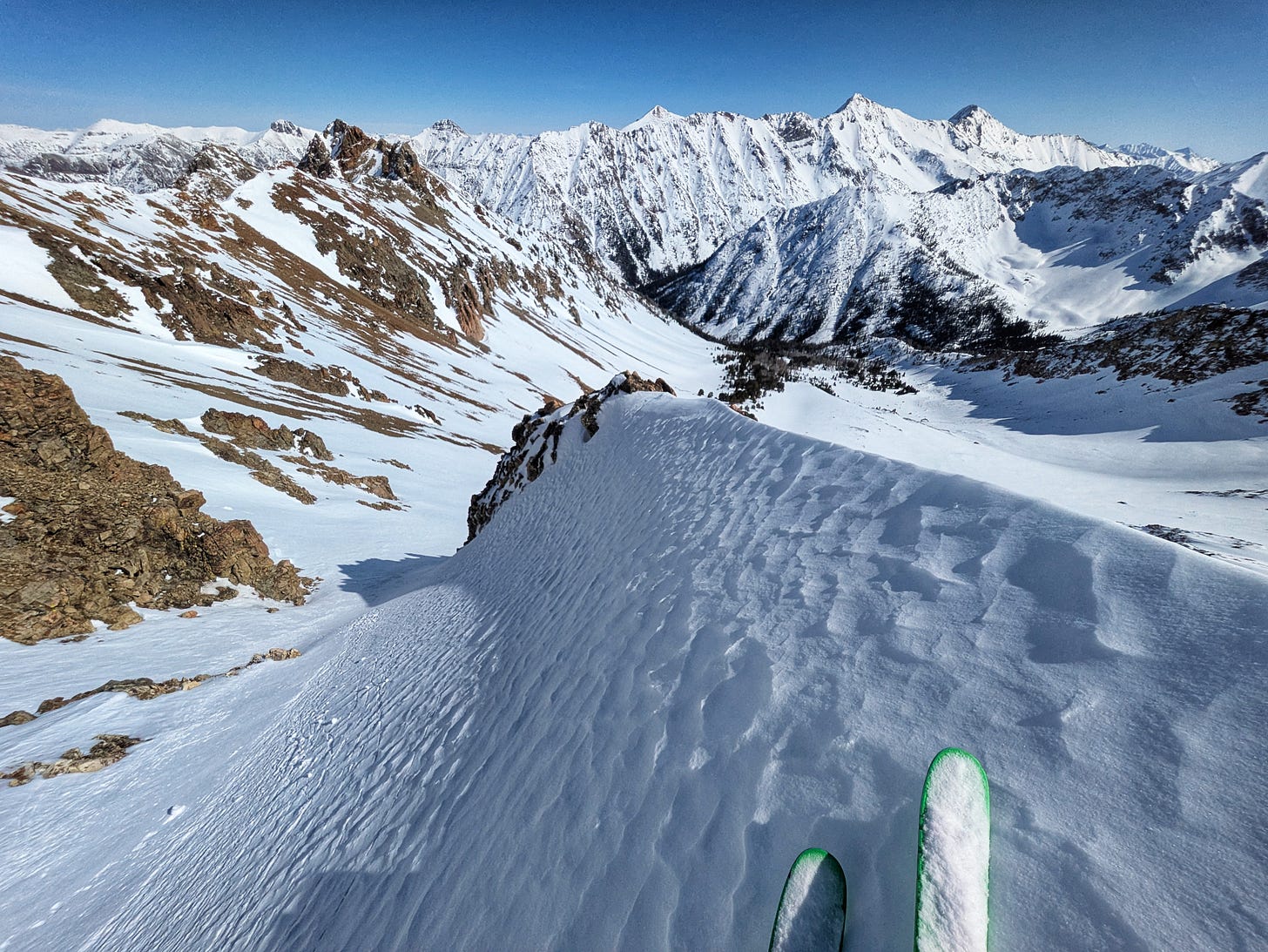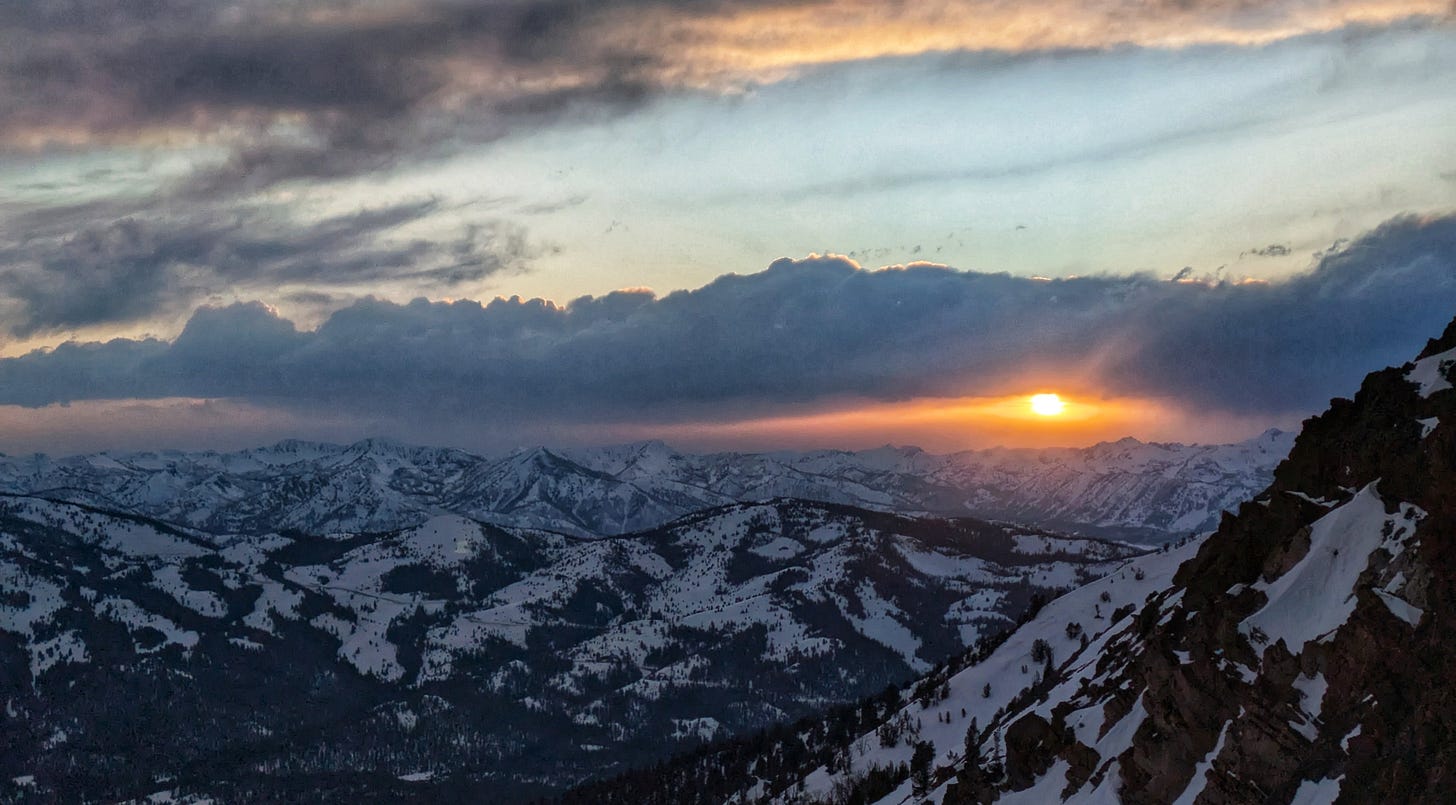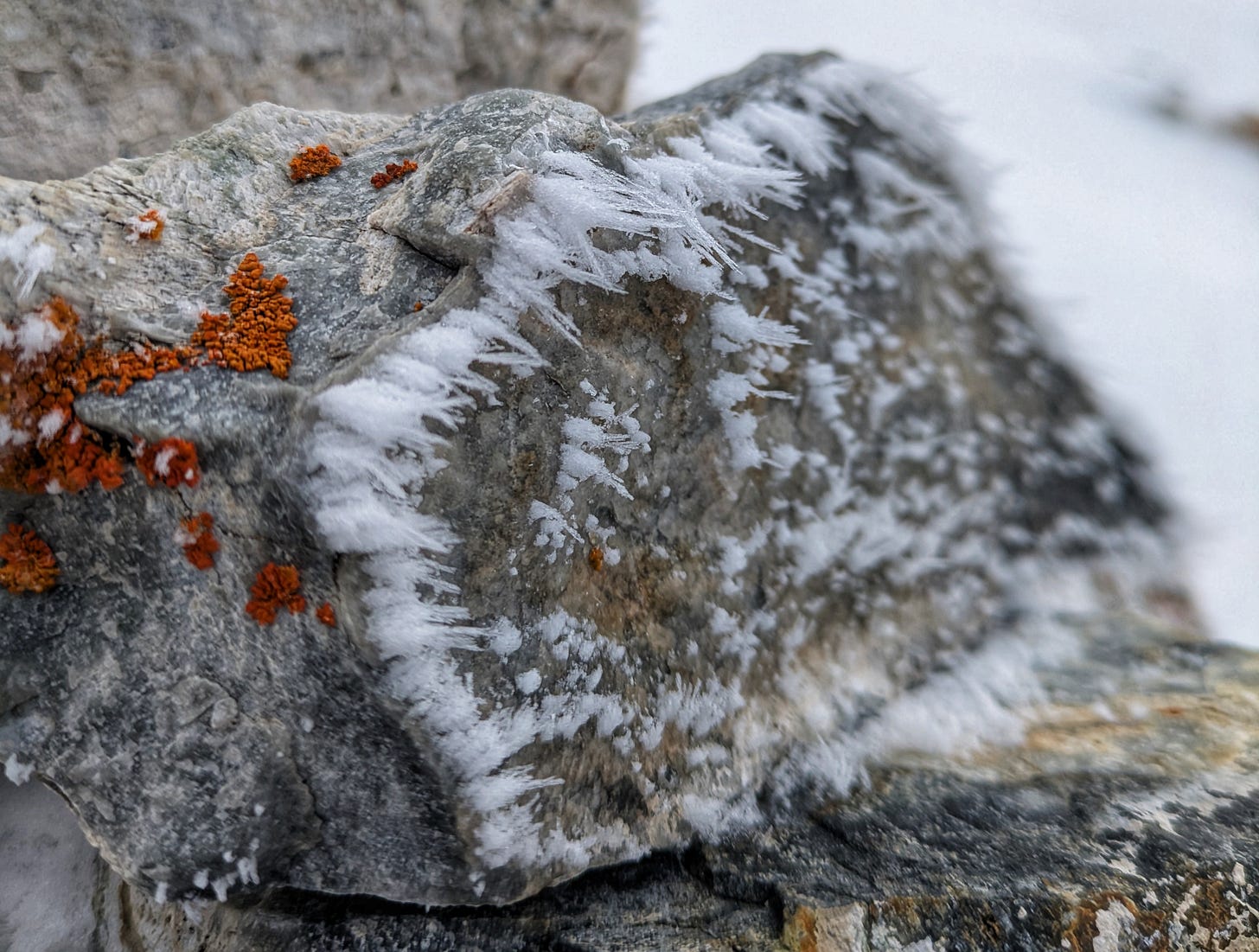Springtime and the living is...variable?
A month of weather whiplash, a discussion of risk homeostasis and spring mindset, a continuing string of avalanche accidents, a hypothetical story about "playing the game", and a look into the future.
Energetic spring weather has arrived in western North America. The days are getting longer, the storms are getting warmer and wilder, and the sun is climbing higher and delivering more radiation with each passing day.
For me, the next month or two are the best part of the season. It’s all been leading up to this. We’ve gradually built our snowpacks all year, watched weak layers get buried, produce avalanche cycles, gain strength and fade into the memory banks. Extended melt-freeze cycles have produced harvestable corn on solar slopes while upper elevation shady slopes stay cold and dry. Vigorous spring storms drop a short stack of new snow on an already blanketed landscape and the next thing you know you are skiing big lines in soft, dry snow.
Of course, it doesn’t always play out that way. Each and every season produces a unique snowpack and each and every spring delivers a unique set of weather conditions. Extended melt (without the freeze) cycles can push water deep into the snowpack where it pools and weakens pre-existing layers and heightens the potential for destructive wet slab avalanches failing on layers of slush. Or springtime droughts build reactive layers of crusts and facets that come alive and make big avalanches when loaded by productive spring storms. Understanding what type of spring weather and snowpack you are dealing with is paramount to safe travel; the snowpack doesn’t care what your calendar says.
WEATHER and SNOWPACK
The past few weeks have delivered a wide range of weather. This tail end of the winter season continues to dish out occasional helpings of cold powder, but it gets harder and harder to keep temperatures low enough for these conditions to stick around long. A few major warm-ups have melted tons of snow down in the valleys and the dirt, grass and sagebrush is reappearing on many slopes. You may have even come across a few spring flowers already.
Here’s a look at where snow has been falling during the month of March, starting where our last update left off on March 8th and continuing through this morning:
A transient ridge of high pressure brought the warmest temperatures of the year during the final week of March, with many locations in the Intermountain West setting high temperature records. This heat and sunshine melted large quantities of snow at the surface and sent significant meltwater down into the snowpack. Wet loose, wet slab, cornice, and glide avalanches topped the problem lists during this period. Some of the largest, most destructive wet snow avalanches were observed in northern Idaho and northwestern Montana, but these problems were widespread across the Western US.
An intense, fast-moving, jet-driven spring storm has drawn a bead on central California to close out March. Yesterday, the Sierra Avalanche Center issued an avalanche warning with a forecasted danger rating of high on all slopes. Moisture and energy from this storm is quickly working westward across the US, bringing heavy snow and plenty of wind to many areas.
The West won’t be the only part of the country to experience extreme weather from this storm. The low pressure center stalls out over the plains, delivering copious amounts of water to the Mississippi River Valley along with the threat of severe thunderstorms developing into supercells and spawning strong tornadoes.
RISK HOMEOSTASIS
As humans, we have an acceptable level of risk that we are comfortable exposing ourselves to. This level varies from person to person but is fairly constant internally. This idea is known as Risk Homeostasis, and it was formalized and popularized by Gerald J S Wilde in his 1982 paper: The Theory of Risk Homeostasis: Implications for Safety and Health.
Here is a quick, common example of the idea: In 1967 Sweden switched from left-hand to right-hand drive traffic. In the year and a half that followed, a significant reduction in traffic fatalities occurred. During that time, as drivers adjusted to the new conditions, they drove slower, paid more attention, and managed their uncertainty by decreasing the amount of risk they were taking. As time passed and the unfamiliarity of driving on the right side of the road became familiar, drivers sped up and reduced their safety margins. By the end of the period, any given driver was about as likely to be killed in a car accident as they had been prior to the switch.
The same process can be observed in the way we travel through the backcountry as conditions become safer and more predictable in the spring. The snowpack transitions to its springtime conformation and we tend to enter larger, more consequential terrain. In doing so, we offset the reduced risk thanks to a more predictable snowpack by putting ourselves into big, remote terrain where the consequences of even small mistakes can be quite high.
More on this in the Playing the Game section below.
ACCIDENTS
It has been another heavy month in the world of snow. Find below a list of recent fatal avalanche accidents in North America. The rate of these accidents has slowed as snowpack stability has improved, but there are some tough reads in here and some of these accidents have landed very close to home for those in the professional snow world. But these always land close to home for somebody. Hug your friends more, and don’t be afraid to tell them how much they mean to you.
(This timeline starts on 3/7; accidents earlier in the season are discussed in previous posts. Click the underlined date/location for more information or an accident report, if available.)
3/7 - Hoyt Peak, UT - A 51-year-old male skier was caught, carried, and fully buried in a large avalanche that he triggered. He was skiing by himself at the time of the accident. This is a detailed, thoughtful accident report that is worth taking the time to read. There is also a sobering video from UAC Forecasters Craig Gordon and Andrew Nassetta that is worth your time.

3/13 - Mt. Bailey, OR - A guided party of snowcat skiers and snowboarders triggered a large storm slab avalanche. Two were partially buried, and one client was fully buried and killed. As is generally the case with accidents involving guided parties, few other details are available.
3/14 - Lake Louise, AB - Two skiers in the backcountry terrain outside of the Lake Louise Ski Area triggered a large (D2.5) deep persistent slab avalanche that caught, carried, and fully buried one of them. The buried skier was located with a transceiver and extricated by their partner, but they did not survive the avalanche. There were many small to medium-sized trees in the starting zone and runout of this avalanche (image below).

3/14 - Black Prince, AB - That same day, about 65 miles southeast, one skier in a group of 4 triggered and was caught, carried, and buried in a large avalanche that broke about 300 feet wide and 3 feet deep on a layer of facets on a crust that formed during the January Drought. As with the slide above, there were many small to medium-sized trees where this avalanche released (image below).
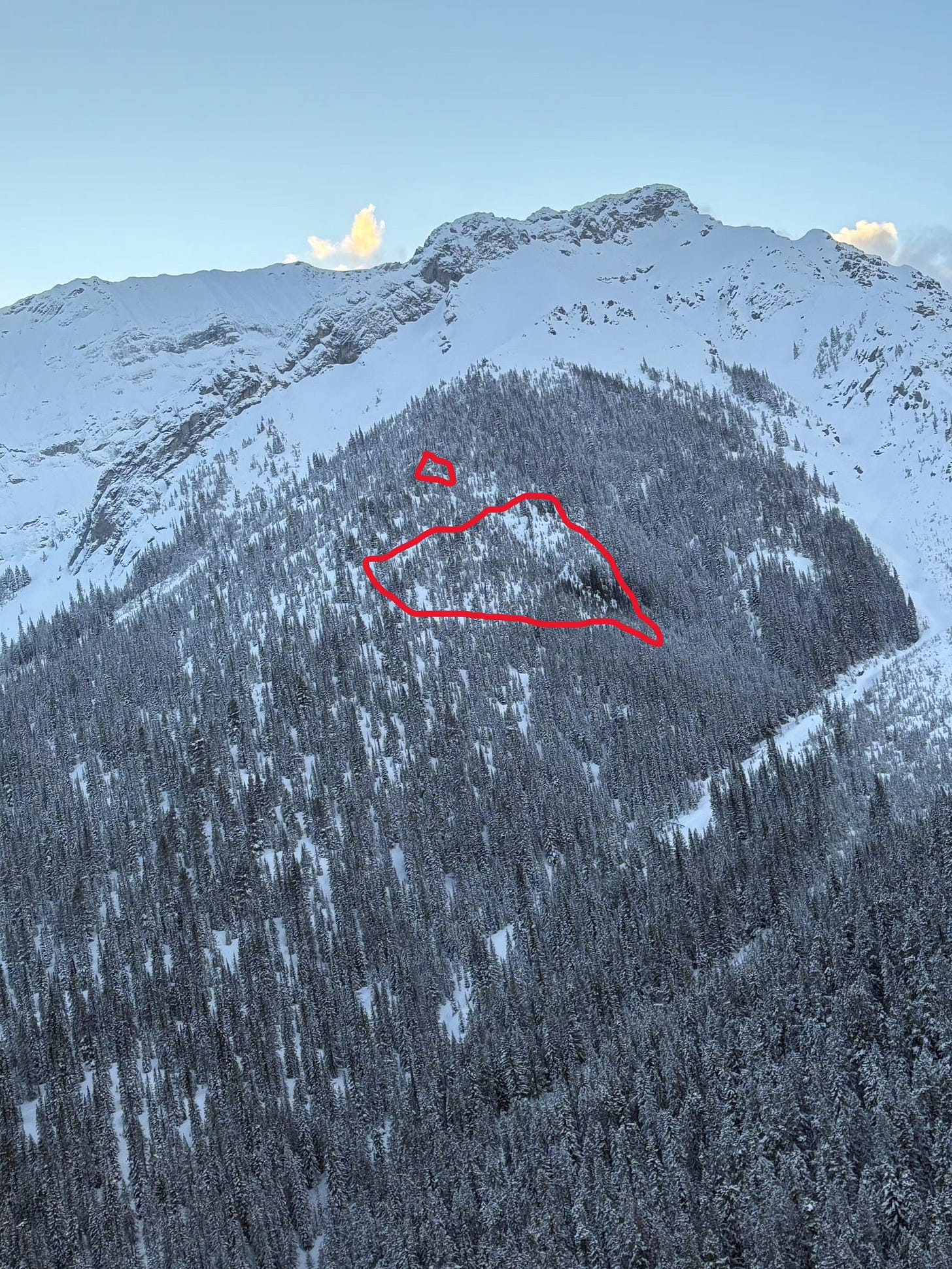
3/22 - Turnagain Pass, AK - A 16-year-old snowmachiner was caught, buried, and killed in a large avalanche. The rider was buried 12 feet deep and was recovered within roughly an hour thanks to the help of other parties in the area. Tragically, this young man was deceased by the time he was freed from the debris. This slide appears to have failed on the same layer of buried surface hoar that killed 3 heli-skiers in nearby terrain on March 4th, 2025.
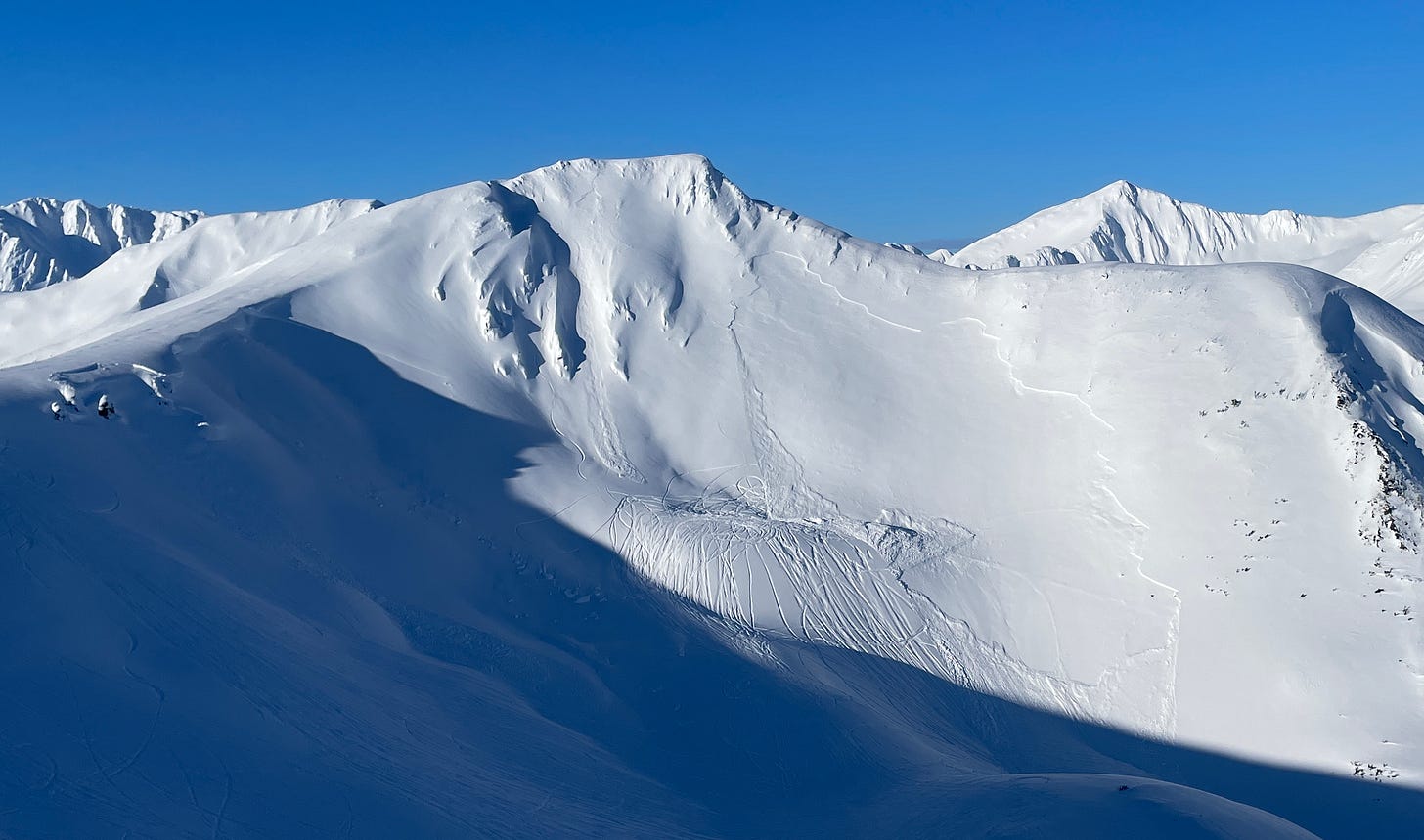
3/24 - Clute Creek, BC - Two groups of heliskiers were waiting at the bottom of their run when a large avalanche released above them. The helicopter pilot saw the avalanche fail and was able to warn the groups via radio. One group was able to escape, while the other group of 4 was caught in the slide. Three of the men were caught, buried, and killed, and the fourth was seriously injured. One of the men killed was the founder and lead guide for the involved heliski operation (Stellar Heliskiing), and the other two had deep ties to the snow world. A media statement from Stellar can be found here.
PLAYING THE GAME
I think of the way that we expose ourselves to hazards in life as “playing the game.” It can feel a bit blunt or crass, but I believe it is an accurate description. Critical to safe travel in avalanche terrain is an honest assessment of the risks you are taking and the game you are playing. It’s important not to downplay or sugarcoat your assessment of this game and its potential consequences.
There is no judgment here, but we have to look the beast square in the eye. If you find yourself unable to do this, I recommend you think hard about the games you are playing. We must be honest with ourselves about what we are doing and what the outcome of coming up short in our game looks like. Winning the game may be the best day of your life, and losing may be the worst. This space between winning and losing is often smaller than you might think and that margin can be razor-thin in high consequence terrain.
When springtime rolls around and we choose to expose ourselves to a full suite of mountaineering hazards along with avalanche hazards, the game we play becomes increasingly complex. We are making many important decisions during big days in the mountains. Let’s take a look at how this plays out in a single, fictional day:
It’s a cold April morning and you and your partner are hungry for a big day. Over a beer or three the night before you've come up with a plan to ski two classic lines on one of the big peaks in your backyard. You’ll start early, double on your sled to cut out a dozen road miles, climb a big south face, drop into the steep terrain on the north side of the peak, climb back up to the top, and exit back to the sled via your morning ascent route.
It has snowed 6-8” over the past two days, following a warm-up that produced a generally stable snowpack. It’s been cold enough to preserve this new snow on steep, shady slopes, but it has been blown off and melted from the south-facing line you plan to climb. Knowing this, you pack crampons. Unfortunately, your partner grabbed the wrong crampons on his way out the door this morning and does not have anything sharp for his feet. No problem, you think. You’ll kick some deeper steps with your front points and he can borrow the axe that has been bouncing around your truck.
The sled ride in is slow, cold, and a bit awkward, but generally uneventful. You have to stop and pack the tunnel with snow a few times to keep the machine from overheating. It’s a cold morning down low and you arrive at the base of the long south face just slightly behind schedule. The crusts are rough here and you are both able to skin up the bottom few hundred feet of the face before it becomes too firm and slick. Here, you stop to transition to booting with crampons. You’re happy to attach your knives to your feet, but you feel uneasy looking at your partner’s naked boots. You hand him the axe and lead the way up the slope.
Everything goes smoothly, but slowly as you ascend. At least for you. You are getting good purchase with each step and moving uphill is fast and easy. Your partner, on the other hand, is working hard to get a boot edge into the icy snow, sometimes kicking hard three, four, five times before he’s comfortable enough to take a step. Your pace slows to a crawl and soon you are well behind schedule. Your partner’s legs are burning and the steep, icy slope stretches out below you, ending at a scree field that neither of you wants to fly into at high speed. You navigate your way to a rock patch in the center of the face and watch with apprehension as your partner scratches their way up to your rocky perch, relying heavily on the axe when their boots periodically loses purchase.
It’s mid-morning now and you are halfway up the face. You had hoped to be at the top. The bands of high clouds that accompanied the sunrise have long since disappeared and the day is starting to feel hot. You suggest waiting here for an hour or so to let the snow surface soften, and your partner readily agrees with a look of relief splashing across their face. You scratch around at the snow surface with your poles as the time ticks by, eventually finding it to be soft enough for your partner to make steps with much less effort and much more confidence. You continue upward together, top out on the peak after noon, and gaze down at the steep, complex, rocky line that drops off the backside. As anticipated, snow conditions here are wildly different from the softening ice that you just climbed.
The snow on the north is dry and cold and there is evidence of recent wind transport at the top of your line. A wide, steep pitch off the summit funnels down to ribbons of snow that cut through the complex rocky face below. All of the sudden you’ve gone from worrying about a slide-for-life fall on a steep icy surface, to the unnerving thought of triggering a slide and being rocketed through a rocky hallway at high speed.
You both transition quickly, aware that you are well behind schedule. Last night, as you laid your plan, you and your partner had both expressed concerns about sensitive wind slabs in this terrain. It’s clear that the wind has been moving snow, but since you just climbed a big ice sheet you don’t have much insight into how the snow on the north side of the peak will behave. Your partner has a renewed sense of courage with their skis strapped to their feet, and they offer to guinea pig the entrance to the line. You feel relieved not to be the first to touch the hanging snowfield.
Your partner eases onto the top of the slope, pokes around with his pole and skis, and reports that there are 12-18” of snow on the firm surface below…significantly more than the 6-8” of recent snow that has fallen. He jumps around a bit with no results and declares he is going to make a ski cut on top of the line, aiming for a lone rock outcrop on the margin of the funnel. He starts to move across the slope and you see a fracture open just above him. He carries his speed and is able to ski off the slab and stop at the outcrop as the slab disintegrates and accelerates into the rocky constriction below. It is quiet for just a moment, and then you hear the increasing growl of the slide as it rips through the belly of the face, reappearing as a powder cloud cascading out onto the apron 2,000’ below.
You stare at each other for a few moments, surveying the scene. Your partner is now standing on the bed surface, which is firm and chalky. After some deliberation, you both decide that since the slide wiped out all of the recent snow, additional avalanche activity is unlikely. You leap-frog your way down the slope, skiing slowly and cautiously on the firm surface. You finally get down to the apron and stare dumbfounded at the size of the debris pile that your initially small avalanche was able to entrain. The hairs on the back of your neck stand up as you imagine what the scene would look like if your next task was to find your partner in the debris.
You are now several hours behind schedule and you still have a big face to climb and another big face to ski before you get back to your sled. You are on the wild side of the mountain, no human soul has been here this year. The weight of your remoteness is heavy on your mind. But you’ve already made all of your decisions and there is no other way back to your vehicle and civilization. The only way out is through. No time for small talk, just time to climb.
You move quickly back up the face. The booting is consistent, predictable, and secure. Left foot, right foot, repeat. Your partner is moving faster than you now, both of you alone with your thoughts. You keep picturing him in the debris below as you climb the steep face, doing your best not to imagine what shape he would have been in if the mountains had played pinball with his body in this unforgiving rocky passage.
The shadows have grown long by the time you make it back to the summit. It’s breezy and the air feels cold. The perfect corn descent you had envisioned looks like it will resemble something closer to ice skating. It is now your turn to feel the embarrassment of not having packed the right gear. You brought your light skis today to help you move quickly, but these sticks have edges that are only marginally sharper than a butter knife. You focus on your turns, one and then the next. You're tired now and it takes most of what you have left to hold things together to the bottom of the face as the sun settles into the horizon.
Another cold, awkward sled ride and you are back to the truck. You drop off your partner and arrive home safely. By the time you walk into the front door it is out there on social media already, the “mission” you “accomplished”. The summit photo in the sun that your partner snapped after your first climb shows your big smile and the not-yet-avalanched start of the north-facing line. You look at that smile and the slope behind you and acknowledge that there is only a fraction of the whole story here and that almost all of the important bits are missing.
And nothing went wrong but you are left wondering how many times things might have gone wrong along the way. How much risk did you eat today? How might the story change if just a few details had been different along the way? How close did you get to the line? Did you cross it and survive through the force of luck alone? Do you know the answers to these questions? Do all of these questions have answers?
And whatever that wild cry was
it will always remain a mystery
you have to go home now and live with,
sometimes with the ease of music, and sometimes in silence,
for the rest of your life.
-Mary Oliver, excerpt from You Are Standing at the Edge of the Woods
LOOKING FORWARD
As today’s storm winds down and moves east, a ridge of high pressure is forecast to set up over the West. This will eventually bring a return of sunshine and another round of very warm temperatures during the first week of April. There is a good chance for breaking more temperature records during this period and wet snow avalanche problems (and flooding) will return in force. Many areas have graduated from the persistent slab problems they developed earlier in the season, but many have not.
This general weather pattern looks like it will dominate most of the month of April. High pressure builds and temperatures soar, only to be swept away by deep low pressure centers and jet-stream driven moisture. Rain in the valleys, snow and graupel in the mountains. Some sun, some snow, the dregs of winter and the appetizer for the spring to come.
Below are the official monthly temperature and precipitation outlooks from the National Oceanic and Atmospheric Administration:
And here are a couple of ways of looking at how our snowpacks across the Western US are faring this season. They usually update these graphics on the first of the month, but the April 1 updates have not been issued yet. A few of the graphics below are from March 1, I’ll update this when the April 1 maps become available.
SURVEYS
Collecting information from and about backcountry users is difficult. Here are three interesting projects that you should participate in:
Sara Boilen and Ian McCammon (big names in the avalanche world, with decades of experience) are developing an open-source tool to help individuals mitigate risk in avalanche terrain. The project's first stage involves interviewing backcountry recreationalists who have been traveling in avalanche terrain for at least one season. You should go fill out this basic initial survey As a bonus, there is an excellent raffle for all participants…
Eastern Oregon University has a survey aimed at better understanding avalanche safety preparedness among motorized backcountry users (including skiers/riders who use a snowmobile for access). Is this you? If so, go take this survey.
AIARE also has a survey out right now, looking at terminology related to avalanche transceiver use. You should take this one too, here is a link.
Phew, I think that will cover it for today. I’ll be writing another one or two more of these updates this spring, depending on how conditions unfold. Thank you for your time and attention, and may you find stable snow and safe travels home at the end of the day. And don’t be shy, tell your friends that you love them while you’re lucky enough to have them in front of you.
Godspeed my friends.
-Ben VandenBos


